Haryana State Board HBSE 10th Class Maths Notes Chapter 3 Pair of Linear Equations in Two Variables Notes.
Haryana Board 10th Class Maths Notes Chapter 3 Pair of Linear Equations in Two Variables
Introduction
We have studied in previous classes about linear equations in one variable. Its general form is ax + b = 0; where a and b are real numbers, a ≠ 0 and x is a variable. If ax + b = 0 ⇒ x = \(-\frac{b}{a}\) is the solution of the equation.
In class IX, we have studied about a linear equation in two variables and its graphical representation The general form of linear equation in two variables is ax + by + c = 0; where a, b, c are real numbers, a ≠ 0, b ≠ 0 and x, y both are variables. Any pair of values of andy which satisfies the equation or ax + by + c = 0, is called its solution. Recall that, the graph of a linear equation in two variables is a straight line. The coordinates of every point on a graph satisfies the given equation and coordinates of every point of a graph is the solution of the equation. In this chapter we shall study about a pair of linear equations in two variables and various methods of solving them as algebraic and graphical. We shall also study about some applications of linear equations in two variables in solving simple problems from different areas.

Pair of linear equations in two variables and their graphical representation
A pair of linear equations in two variables is said to form a system of simultaneous linear equations in two variables.
The general form of a pair of linear equations in two variables x and y is :
a1x + b1y + c1 = 0
and a2x + b2y + c2 = 0.
Where a1, a2, b1, b2, c1, c2 are all real numbers and a1 ≠ 0, b1 ≠ 0, a2 ≠ 0, b2 ≠ 0, aa12 + b12 ≠ 0, and a22 + b22 ≠ 0. A pair of values of x and y satisfying each one of the given equations is called a solution of the system.
For example: x = 2, y = -2 is the solution of the simultaneous equations in two variables 2x + y = 2 and x – y = 4.
2. The system of simultaneous linear equations in two variables have either a unique solution, or infinitely many solutions or no solution. A system of simultaneous linear equation in two variables could be either consistent or inconsistent.
Consistent System : A system of simultaneous linear equations is said to be consistent, if it has at least one solution.
For example : x = 2, y = 1 is the solution of linear equations 2x + 3y = 7 and 2x – y = 3. So, these linear equations are consistent
Inconsistent System : A system of simultaneous linear equations is said to be inconsistent if it has no solution.
For example. The system of linear equations x + 3y = 4 and 3x + 9y = 10 has no solution. So, these linear equations are inconsistent.
![]()
Graphical Representation of Linear Equations in two Variables
We know that the graph of a linear equations in two variables is a straight line. We have studied in class IX that for the given two lines in a plane, only one of the following three possibilities are there :
- The two lines will intersect at one point.
- The two lines will not intersect, i.e., they are parallel.
- The two lines will be coincident, i.e., one line overlaps the other line.
Thus, the graphical representation of a pair of simultaneous linear equations in two variables will be in one of the ahead forms:
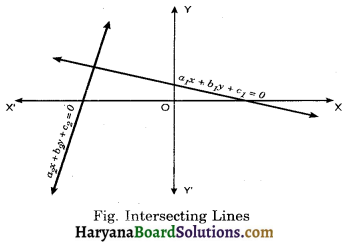
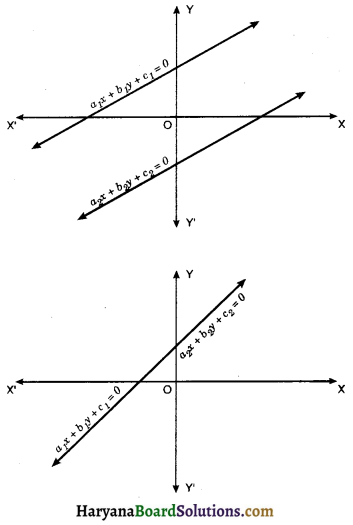
Fig. Parallel Lines Coincident Lines i.e. one line overlap other line
Graphical Method of Solution of a pair of Linear Equations
Let a1x + b1y + c1 = 0 and a2x + b2y + c2 = 0 are two linear equations and on comparing the efficients of x, y and c1, c2, there are three possible cases :
Case I : If \(\frac{a_1}{a_2} \neq \frac{b_1}{b_2}\), then graphs of the equations a1x + b1y + c1 = 0 and a2x + b2y + c2 = 0 intersect each other at a point P(α, β) as shown in the figure. Then a = α, y = β is the unique solution of the given linear equations. If \(\frac{a_1}{a_2} \neq \frac{b_1}{b_2}\), then the pair of linear equation is consistent.

Case II: If \(\frac{a_1}{a_2}=\frac{b_1}{b_2} \neq \frac{c_1}{c_2}\), then graphs of equations, a1x + b1y + c1 = 0 and a2x + b2y + c2 = 0 are parallel lines. Therefore, there is no solutions of given equations and the pair of linear equations is inconsistent.
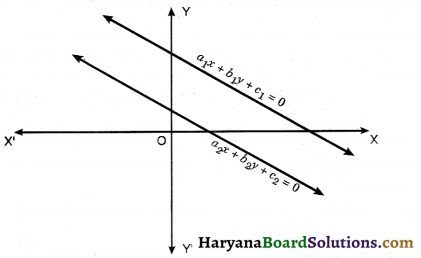
Case III : If \(\frac{a_1}{a_2}=\frac{b_1}{b_2}=\frac{c_1}{c_2}\), then the graphs of equations a1x + b1y + c1 = 0 and a2x + b2y + c2 = 0, are coincident lines. Hence, the linear equations have infinitely many solutions. In this case the pair of linear equations is consistent.
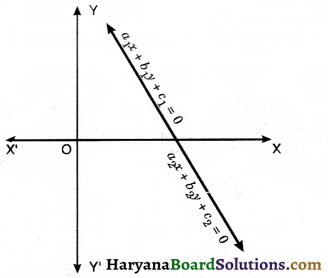
We show these cases by the ahead table :

![]()
Algebraic Methods for Solving a Pair of Linear Equations
In the previous section we discussed to solve a pair of linear equations in two variables by graphical method. This method is not convenient in such cases when the point representing the solution of the linear equations has non-integral values like (-2.37, 4.19), (\(\frac{1}{9}, \frac{1}{17}\)), etc. It gives us approximate values of x and y. Algebraic methods provide us exact and correct solution of every pair of linear equations.
The most commonly used algebraic methods of solving a pair of linear equations in two variables are as follows:
(a) Substitution Method
(b) Elimination Method
(c) Cres Multiplication Method.
(a) Substitution Method
Working Rule :
Step-1: Find out the value of any one of the two variable in terms of the other from any one of the two given equations.
Step-2: Sabattute this value in other equation This gives us a linear equation in one variable.
Step-3: Solve the linear equation and get the value of variable, which obtained in Step 2.
Step-4: Put this value in any one of the given equations and get the value of other variable.
Step-5: The values of and y obtained from Step-3 and 4 respectively, in the solution of the given two linear equations
(b) Elimination Method by Equating Coefficients:
Working rule :
Step-1: Multiply the given equations by suitable non zero real numbers so as to make the coeficients of any of the one variable numerically equal in both equations.
Step-2: Add or wubtract new equations so obtained to eliminate the one variable of both equntions whose coefficients are numerically equal.
Step-3: Solve the simple equation in one variable thus obtained.
Step-4: Substitute the value found in step 8 in any one of the given equations and find the value of other variable.
(c) Cross Multiplication Method
Working Rule:
Consider a system of linear equations in two variables x and y.
a1x + b1y + c1 = 0; a1 ≠ 0, b1 ≠ 0 ……(1)
a2x + b2y + c2 = 0; a2 ≠ 0, b2 ≠ 0 ……(2)
Let us solve the system of equations by elimination method as follows:
Step 1 : Multiplying equation (1) by b2, and equation (2) by b1, we get
b2a1x + b2b1y + b2c1 = 0 ……(3)
b1a2x + b1b2y + b1c2 = 0 ……(4)
Step 2: Subtracting equation (4) from equation (3), we get
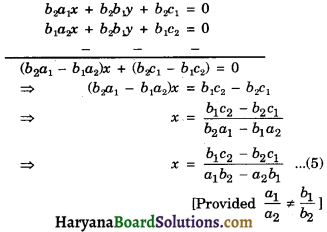
Step 3: Substituting the value of in equation (1), we get


Thus, x and y can be obtained from equations (5), (6) as formula.
The following diagram helps in writing the above solution :

The downward arrows indicate the first product while the upward arrow indicate the second product. The second product is to be subtracted from the first product. Since the denominators have been obtained by cross multiplying the coefficients, this method is known as the method of cross multiplication for solving a system of linear equation.
Remarks: If we write the system of linear equations as :
a1x + b1y = c1
and a2x + b2y = c2
Then the following diagram helps in writing the solution:

Conditions for solvability of linear equations : Consider the system of a pair of linear equations :
a1x + b1y + c1 = 0
and a2x + b2y + c2 = 0
(1) If \(\frac{a_1}{a_2} \neq \frac{b_1}{b_2}\)
Then equations has unique solution i.e, system is consistent.
(2) If \(\frac{a_1}{a_2}=\frac{b_1}{b_2}=\frac{c_1}{c_2}\)
Then equations has infinitely many solutions Le system is consistent.
(3) If \(\frac{a_1}{a_2}=\frac{b_1}{b_2} \neq \frac{c_1}{c_2}\)
Then equations has no solution i.e. system is inconsistent.
![]()
Equations Reducible to a pair of Linear Equations in Two Variables
In this process, we shall discuss the solution of such pairs of equations which are not linear but can be reduced to linear form by making some suitable substitutions. The process of solving the system of equations involving such cases has been explained through some examples. We solve obtained linear equations by any algebraic method.